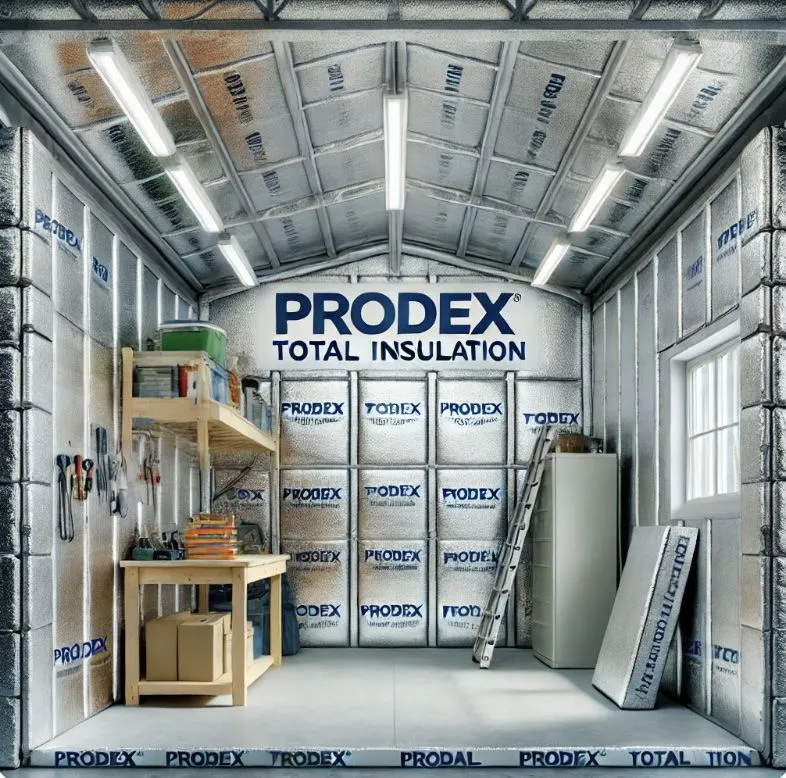Metal Garage Insulation: The Best DIY Solution for Comfort & Condensation Control
Why Metal Garage Insulation Matters
A metal garage is durable and versatile — but without insulation, it can become uncomfortably hot in summer, freezing in winter, and prone to condensation issues that damage vehicles, tools, and equipment.
Proper metal garage insulation helps you:
Maintain year-round comfort
Stop condensation and rust
Reduce energy costs
Make your garage a usable workshop or storage space
Common Metal Garage Insulation Options
Fiberglass Insulation
Pros: Widely available, low upfront cost, decent R-value.
Cons: Absorbs moisture, loses effectiveness when wet, prone to mold and mildew, messy to install.
Verdict: Not ideal for metal garage insulation where condensation is a concern.
Spray Foam Insulation
Pros: Creates airtight seal, excellent thermal barrier.
Cons: Expensive, requires professional installation, doesn’t reflect radiant heat, difficult to remove.
Verdict: Effective but not budget-friendly or DIY-friendly.
Reflective Insulation (Prodex Total)
Pros: Combines closed-cell foam with reflective foil, prevents condensation, easy for DIY installation, cost-effective.
Cons: Requires seams to be properly sealed.
Verdict: Best balance of cost, effectiveness, and ease of use for metal garages.
How to Insulate a Metal Garage (DIY Guide)
If you’re tackling DIY metal garage insulation, here’s a straightforward process:
Plan and Measure – Measure walls, ceilings, and doors to calculate material needs.
Select Your Insulation – Choose 10M, or Fast Action Prodex Total Insulation Plus, both designed for metal building condensation control.
Prepare Surfaces – Clean garage panels, remove debris, and seal obvious gaps.
Install the Insulation – Attach to framing using screws, pins, or banding.
Seal All Joints – Prevent warm air from reaching cold metal — this step is critical for condensation control. Fortunately, 10M and Fast Action don't require seam tape to seal the seams/joints.
Inspect and Maintain – Regularly check for gaps or damage and reseal as needed.
With these steps, you can finish a DIY insulation project in a weekend with basic tools. For a more thorough, detailed guide (especially for complex builds or existing metal structures), check out our “How To Insulate A Metal Building: Master Guide.”
Condensation Control for a Metal Garage
Condensation is the #1 problem with metal buildings. When warm, moist air inside the garage touches cold metal, water droplets form — leading to corrosion, mold, and dripping ceilings.
Prodex Total prevents this by:
Acting as a built-in vapor barrier
Providing a thermal break with closed-cell foam
Reflecting up to 97% of radiant heat
If you want to learn more about why condensation is such a challenge — and how insulation solves heat, cold, and air problems in metal buildings — also see our related guide on Metal Building Insulation – Stop Condensation, Heat, Cold & Air.
Keeping Your Metal Garage Cool: Stopping Radiant Heat
One of the biggest issues with metal garages is overheating in summer. Metal siding and roofing absorb the sun’s energy and radiate that heat inward, turning your garage into an oven.
Prodex Total solves this problem by blocking 97% of radiant heat transfer. The reflective foil surfaces act like a shield, bouncing heat away before it can enter the building. Combined with the foam core that reduces conductive heat flow, this creates a dramatic difference in indoor comfort.
Benefits of radiant heat control include:
Cooler garage temperatures in hot weather
Reduced strain on cooling systems (if air-conditioned)
Protection for tools, vehicles, and equipment from heat damage
A more comfortable workspace year-round
This radiant barrier feature is what sets Prodex apart from fiberglass and spray foam — neither of which can effectively stop radiant heat from penetrating a metal garage.
Why Prodex Total Is the Best Metal Garage Insulation
Unlike fiberglass or spray foam, Prodex Total provides a 3-in-1 solution:
Thermal insulation
Vapor barrier for condensation control
Radiant heat reflection
It’s also lightweight, cost-effective, and designed for DIY installation. With the Fast Action version, seams seal automatically — saving time and eliminating the need for reflective tape.







